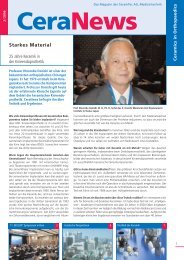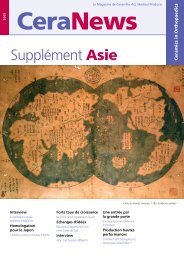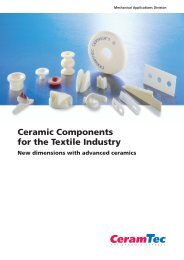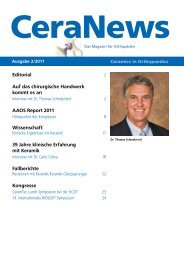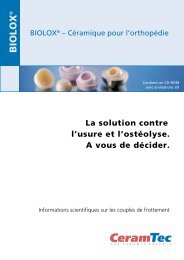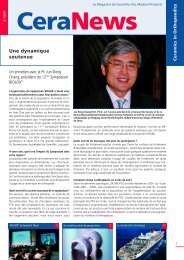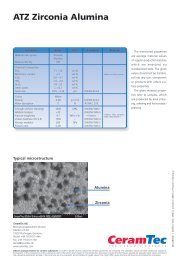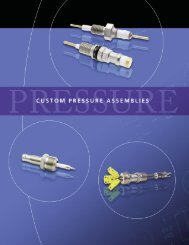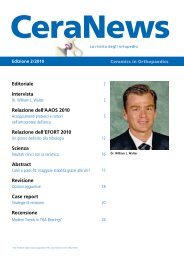Download PDF, 2.4 MB - CeramTec
Download PDF, 2.4 MB - CeramTec
Download PDF, 2.4 MB - CeramTec
Create successful ePaper yourself
Turn your PDF publications into a flip-book with our unique Google optimized e-Paper software.
InterviewSetting far-reaching quality standardsGermany could soon have new quality assurance steps aimedat providers of joint replacement. In addition to the arthroplastyregistry, a tool used for the continuous monitoring of the qualityof outcomes, EndoCert, the certification program of the specialistsocieties for orthopaedic surgery, is aimed at establishing anotherpillar in quality assurance.The EndoCert process could be used to ensure certified processand structural quality for arthroplasty centers. In this respect,it is the declared goal of the specialist societies to promote thecertification of arthroplasty centers on a voluntary basis withan established quality standard and thus to achieve further improvementin patient care. This will involve analyzing the entirecare process, defining the qualifications for users and structuralquality for medical institutions, and following tried and testedstandards.Wolfram Mittelmeier, MD,PhD, is the Director of theOrtho paedic Clinic and OutpatientCenter at RostockUniversity as well as beingPresident of the GermanSociety for Orthopaedicsand Orthopaedic Surgery(DGOOC) for 2012 and ofthe German Society forOrtho paedics and TraumaSurgery (DGOU) for 2012.CeraNews 1/2012CeraNews spoke with Wolfram Mittelmeier, MD, PhD, President of theDGOOC and the DGOU for 2012, and one of the founders of the initiative,about his goals for the coming year and his ideas on quality assurancewithin the field.What are your goals for your term as president?The central theme on which we want to focus in conjunction with my colleaguesChristoph Josten, MD, PhD (German Society of Traumatology, DGU),and Andreas Gassen, MD (Professional Association of Orthopaedics and Traumatology,BVOU), in 2012 is the immanent conflict of the principles of quality,ethics and efficiency. The problem lies in substantially increasing quality,especially in the perioperative and early post-op periods, in a reproducible mannerthroughout Germany to achieve strict conformity and without short-termchanges to the legal framework.Thus, for musculoskeletal trauma, a formidable trauma network based in particularon structural quality is already being established. This will certainly resultin valuable approaches to the continued improvement of trauma care.The EndoCert initiative was developed to establish a quality assurance modelfor arthroplasty similar, for example, to the one which already exists for tumorcenters. The quality of care will be assured and improved based on the qualityof structures, process, and outcomes. It is essential that this should help us toachieve benefits for the patients.What will that look like in practice?It starts with a catalog of minimum structural requirements for a clinic practicingmajor joint arthroplasty. Interaction between the surgery unit and otherdepartments such as anaesthesia and radiology must follow clearly definedquality conventions. For example, findings must be evaluated within strictlydefined time frames and x-ray imaging must really meet certain criteria so thatthe quality of the implantation procedure can also be verified reliably. Standardsare being developed for a large number of subprocesses, ranging from documentationto follow-up. However, the standards will become simpler and moretransparent for those involved thanks to the standard.It cannot be the goal that every clinic needs to develop its own processes toensure high-quality workflows. In future, standards could be agreed which simplifyworkflows, increase safety, reduce administrative costs, and create transparency– for everyone involved.Does the qualification of physicians and OR staffhave a role to play?Of course. Medical devices and technologies mustonly be used if training has demonstrably beenprovided in handling them. The motto "no train,no use" applies to everyone, from the surgeon tothe OR nurse. But this must not mean only applyto the usual, one time demonstration of an implantsystem. A valid, good "training status" must beattained and maintained, comparable to an athlete.It cannot be that a surgeon only performs arthroplastiesvery rarely. We rely on a minimum numberof arthroplasties which the participating clinics willcommit themselves to observe. A surgeon acting asa lead physician responsible for a procedure must,for example, perform at least 50 hip or knee arthroplastiesper year. Those performing revisions mustdemonstrate that they perform 100 arthroplastiesper year for the joint concerned. These are what wecall Lead Surgeons. They must be clearly appointedand associated with the center.Your clinic and some others have already tested thisprocess in the pilot phase. What have been yourexperiences?We started the first pilot run at Rostock Universityin 2007 and were then able to get the participantsfrom the Conference of Tenured Professors ofOrthopaedics and the DGOOC to assist in furtherdeveloping the system. An expert panel from theGerman Society for Orthopaedics and OrthopaedicSurgery coordinated by K.-P. Günther, MD, PhD,has been examining the further development ofquality criteria since 2009 and is also engaged ina Germany-wide review of the system at what areknown as the pilot clinics. A certification board (H.8



